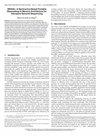T-CAT:具有内存交错的分层内存系统的动态缓存分配
IF 1.4
3区 计算机科学
Q4 COMPUTER SCIENCE, HARDWARE & ARCHITECTURE
引用次数: 0
摘要
新的内存互连技术,如Intel的Compute Express Link(CXL),通过在主内存系统中添加无CPU的NUMA节点,有助于扩展内存带宽和容量,解决不断增长的内存墙挑战。因此,现代计算系统包含了存储器系统的异构性,将存储器系统与具有近存储器和远存储器的分层存储器系统(例如,本地DRAM和CXL-DRAM)组合在一起。然而,由于两种类型的内存之间的访问延迟差异,将NUMA交错应用于分层内存系统可能会面临挑战,这可能会导致内存密集型工作负载的性能下降。NUMA交错可以通过利用节点级并行性和利用聚合带宽来提高性能。通过应对这些挑战,我们首先研究了NUMA交织对分层存储系统性能的影响。我们观察到,虽然NUMA交织对于要求高内存带宽的应用程序至关重要,但它可能会对要求低内存带宽的程序的性能产生负面影响。接下来,我们提出了一种称为T-CAT的动态缓存管理,它在近内存和远内存之间划分最后一级缓存,旨在通过访问远内存来缓解性能下降。T-CAT试图通过重新调整缓存分区的大小来减少近内存和远内存之间平均访问延迟的差异。通过动态缓存管理,T-CAT可以保留NUMA交织的性能优势,同时减轻远程内存访问造成的性能下降。我们的实验结果表明,与在没有缓存管理的情况下使用NUMA交织的情况相比,T-CAT的性能提高了17%。本文章由计算机程序翻译,如有差异,请以英文原文为准。
T-CAT: Dynamic Cache Allocation for Tiered Memory Systems With Memory Interleaving
New memory interconnect technology, such as Intel's Compute Express Link (CXL), helps to expand memory bandwidth and capacity by adding CPU-less NUMA nodes to the main memory system, addressing the growing memory wall challenge. Consequently, modern computing systems embrace the heterogeneity in memory systems, composing the memory systems with a tiered memory system with near and far memory (e.g., local DRAM and CXL-DRAM). However, adopting NUMA interleaving, which can improve performance by exploiting node-level parallelism and utilizing aggregate bandwidth, to the tiered memory systems can face challenges due to differences in the access latency between the two types of memory, leading to potential performance degradation for memory-intensive workloads. By tackling the challenges, we first investigate the effects of the NUMA interleaving on the performance of the tiered memory systems. We observe that while NUMA interleaving is essential for applications demanding high memory bandwidth, it can negatively impact the performance of applications demanding low memory bandwidth. Next, we propose a dynamic cache management, called
T-CAT
, which partitions the last-level cache between near and far memory, aiming to mitigate performance degradation by accessing far memory.
T-CAT
attempts to reduce the difference in the average access latency between near and far memory by re-sizing the cache partitions. Through dynamic cache management,
T-CAT
can preserve the performance benefits of NUMA interleaving while mitigating performance degradation by the far memory accesses. Our experimental results show that
T-CAT
improves performance by up to 17% compared to cases with NUMA interleaving without the cache management.
求助全文
通过发布文献求助,成功后即可免费获取论文全文。
去求助
来源期刊

IEEE Computer Architecture Letters
COMPUTER SCIENCE, HARDWARE & ARCHITECTURE-
CiteScore
4.60
自引率
4.30%
发文量
29
期刊介绍:
IEEE Computer Architecture Letters is a rigorously peer-reviewed forum for publishing early, high-impact results in the areas of uni- and multiprocessor computer systems, computer architecture, microarchitecture, workload characterization, performance evaluation and simulation techniques, and power-aware computing. Submissions are welcomed on any topic in computer architecture, especially but not limited to: microprocessor and multiprocessor systems, microarchitecture and ILP processors, workload characterization, performance evaluation and simulation techniques, compiler-hardware and operating system-hardware interactions, interconnect architectures, memory and cache systems, power and thermal issues at the architecture level, I/O architectures and techniques, independent validation of previously published results, analysis of unsuccessful techniques, domain-specific processor architectures (e.g., embedded, graphics, network, etc.), real-time and high-availability architectures, reconfigurable systems.
 求助内容:
求助内容: 应助结果提醒方式:
应助结果提醒方式:


